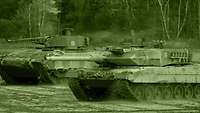How does it feel to be an armoured infantry soldier?
How does it feel to be an armoured infantry soldier?
- Date:
- Place:
- Hagenow
- Reading time:
- 4 MIN
Handling of small arms weapons, training with the Marder armoured infantry fighting vehicle, acting as a group: Following their basic training, officer candidates attend the armoured infantry basic course, which also marks the beginning of the specialisation of their military career. The advanced individual training conducted at 401 Armoured Infantry Battalion in Hagenow aims at giving the future leadership personnel a realistic impression of their profession.
“This was the worst we’ve had to go through so far!”, says a private with a twinkle in his eye after the hatch of the Marder AIFV has closed. It has been his first encounter with a muddy waterhole. You get stuck quicker than you would like to. Particularly if you are tasked to seize a waterway crossing and have to get past the bridge in a swampy area of land. Getting wet is often part of the fight to secure defiles.
Difference between an order and its execution
This is only one of many basic experiences that the new officer candidates could make at 401 Armoured Infantry Battalion in Hagenow. “By participating in this course, tomorrow’s young leadership personnel are not only offered an opportunity to gain their first experience with the Marder AIFV but also to make many more. Such joint experiences make for a sound esprit de corps”, one of the section leaders says and continues: “We teach the young servicemen and women the basics of the armoured infantry’s trade. By hands-on experience, they will then learn to understand where the difference is between an order and its execution. The former requires the brain to perform, the latter the body.”
The armoured infantry basic course takes place immediately after the basic training to familiarise the soldiers with their future tasks as early as possible. Having learned, during the first three months, how to wear a uniform, how to salute superiors and how to use a G36 rifle, the officer candidates move on to the armoured infantry forces at Hagenow to broaden their skill set as soldiers. During the three months of this advanced individual training, in the fourth quarter of the year, they are taught how to handle different small-arms weapons and the Marder AIFV but also how to behave and act as part of a group.
How does a shoulder-fired antitank weapon work?
In October, the groundwork was laid in terms of training fundamentals: How to disassemble an MG5 machine gun? How does a shoulder-fired antitank weapon work? What is the purpose of a grenade launcher? Such questions were first answered during elementary instruction or while the soldiers were learning in their accommodation. This was followed by practical exercises according to the motto “Practice makes perfect.” In addition to the equipment, the officer candidates also got acquainted with different procedures: the armour-killer team, the skirmish line, the squad column formation and the section performing security functions. This interplay between theoretical and practical training was well received by the young servicemen and women. “It’s amazing what can be achieved in only one week. It was just as I have imagined”, a private sums up.
Instead of fundamentals, the training schedule in the second month focused on subjects that are specific to armoured infantry, for example mounting and dismounting a Marder AIFV, which, in military terms, is a change in the method of fighting, cooperation in the Marder AIFV and marksmanship training. The servicemen and women have been outside in all weathers for five weeks - a new experience for many of them. The highlight of the course was the two-week stay at the Putlos training area where one week of marksmanship training was conducted and where, in the second week, the final event of the advanced individual training took place: a section-level live fire exercise interacting with the Marder AIFV.
Facing deprivations as a team
As the company commander puts it, the following has been particularly important to the Armoured Infantry Battalion when conducting this training course: “Although COVID-19Coronavirus Disease 2019 did not make it particularly easy, each participant has made contact with armoured infantry.” By the term “making contact”, he refers to the past months which were characterized by sharing strain and hardship as a team and collectively suffer deprivations and grow with the demands - which is what being an armoured infantry soldier is all about.
Those who have successfully completed the course will now attend the officer cadet course at the Armour School and additional training courses on their way to the officer’s rank. After that, most of them will go to university and some of them will return to the field units.








